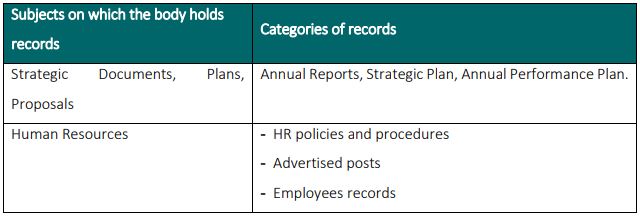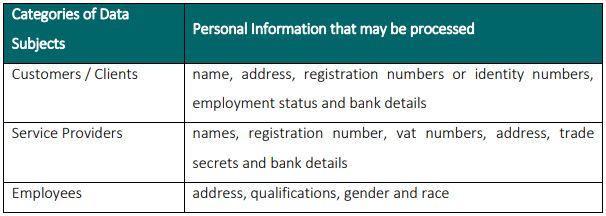PAIA Manual
BELLOW & BUS (PTY) LTD
2012/015833/07
Prepared in terms of section 51 of the Promotion of Access to Information Act 2 of 2000 (as amended).
1. List Of Acronyms And Abbreviations
1.1 “CEO” Chief Executive Officer
1.2 “DIO” Deputy Information Officer;
1.3 “IO” Information Officer;
1.4 “Minister” Minister of Justice and Correctional Services;
1.5 “PAIA” Promotion of Access to Information Act No. 2 of 2000 (as Amended;
1.6 “POPIA” Protection of Personal Information Act No.4 of 2013;
1.7 “Regulator” Information Regulator; and
1.8 “Republic” Republic of South Africa
This PAIA Manual is useful for the public to-
2.1 check the categories of records held by a body which are available without a person having to submit a formal PAIA request;
2.2 have a sufficient understanding of how to make a request for access to a record of the body, by providing a description of the subjects on which the body holds records and the categories of records held on each subject;
2.3 know the description of the records of the body which are available in accordance with any other legislation;
2.4 access all the relevant contact details of the Information Officer and Deputy Information Officer who will assist the public with the records they intend to access;
2.5 know the description of the guide on how to use PAIA, as updated by the Regulator and how to obtain access to it;
2.6 know if the body will process personal information, the purpose of processing of personal information and the description of the categories of data subjects and of the information or categories of information relating thereto;
2.7 know the description of the categories of data subjects and of the information or categories
of information relating thereto;
2.8 know the recipients or categories of recipients to whom the personal information may be supplied;
2.9 know if the body has planned to transfer or process personal information outside the Republic of South Africa and the recipients or categories of recipients to whom the personal information may be supplied; and
2.10 know whether the body has appropriate security measures to ensure the confidentiality, integrity and availability of the personal information which is to be processed.
3. Key Contact Details For Access To Information Of Bellow and Bus (PTY) Ltd
3.1. Chief Information Officer
Name: Petrus Herbst
Tel: (010) 1092727
Email: petrus@arkaios.co.za
3.2. Deputy Information Officer (NB: if more than one Deputy Information Officer is designated, please provide the details of every Deputy Information Officer of the body designated in terms of section 17 (1) of PAIA.
Name: Mariette van der Vyver
Tel: (010) 1092727
Email: mariette@bellowbus.co.za
3.3 Access to information general contacts
Email: info@bellowbus.co.za
3.4 National or Head Office
Postal Address: Same as physical Address.
Physical Address: 48A Morris Street, Meyerton, 1961
Telephone: (010) 1092727
Email: info@bellowbus.co.za
4. Guide On How To Use PAIA and How To Obtain Access To The Guide
4.1. The Regulator has, in terms of section 10(1) of PAIA, as amended, updated and made available the revised Guide on how to use PAIA (“Guide”), in an easily comprehensible form and manner, as may reasonably be required by a person who wishes to exercise any right contemplated in PAIA and POPIA.
4.2. The Guide is available in each of the official languages and in braille.
4.3. The aforesaid Guide contains the description of-
4.3.1. the objects of PAIA and POPIA;
4.3.2. the postal and street address, phone and fax number and, if available, electronic mail address of-
4.3.2.1. the Information Officer of every public body, and 4.3.2.2. every Deputy Information Officer of every public and private body
designated in terms of section 17(1) of PAIA1 and section 56 of POPIA2;
4.3.3. the manner and form of a request for-
4.3.3.1. access to a record of a public body contemplated in section 113; and
4.3.3.2. access to a record of a private body contemplated in section 504;
4.3.4. the assistance available from the IO of a public body in terms of PAIA and POPIA;
4.3.5. the assistance available from the Regulator in terms of PAIA and POPIA;
4.3.6. all remedies in law available regarding an act or failure to act in respect of a right or duty conferred or imposed by PAIA and POPIA, including the manner of lodging-
4.3.6.1. an internal appeal;
4.3.6.2. a complaint to the Regulator; and
4.3.6.3. an application with a court against a decision by the information officer of a public body, a decision on internal appeal or a decision by the Regulator or a decision of the head of a private body;
1 Section 17(1) of PAIA- For the purposes of PAIA, each public body must, subject to legislation governing the employment of
personnel of the public body concerned, designate such number of persons as deputy information officers as are necessary to
render the public body as accessible as reasonably possible for requesters of its records.
2 Section 56(a) of POPIA- Each public and private body must make provision, in the manner prescribed in section 17 of the
Promotion of Access to Information Act, with the necessary changes, for the designation of such a number of persons, if any, as
deputy information officers as is necessary to perform the duties and responsibilities as set out in section 55(1) of POPIA.
3 Section 11(1) of PAIA- A requester must be given access to a record of a public body if that requester complies with all the
procedural requirements in PAIA relating to a request for access to that record; and access to that record is not refused in terms of
any ground for refusal contemplated in Chapter 4 of this Part.
4 Section 50(1) of PAIA- A requester must be given access to any record of a private body if-
a) that record is required for the exercise or protection of any rights;
b) that person complies with the procedural requirements in PAIA relating to a request for access to that record; and
c) access to that record is not refused in terms of any ground for refusal contemplated in
4.3.7. the provisions of sections 145 and 516 requiring a public body and private body, respectively, to compile a manual, and how to obtain access to a manual;
4.3.8. the provisions of sections 157 and 528 providing for the voluntary disclosure of categories of records by a public body and private body, respectively;
4.3.9. the notices issued in terms of sections 229 and 5410 regarding fees to be paid in relation to requests for access; and
4.3.10. the regulations made in terms of section 9211.
4.4. Members of the public can inspect or make copies of the Guide from the offices of the public and private bodies, including the office of the Regulator, during normal working hours.
4.5. The Guide can also be obtained-
4.5.1. upon request to the Information Officer;
4.5.2. from the website of the Regulator (https://www.justice.gov.za/inforeg/).
5 Section 14(1) of PAIA- The information officer of a public body must, in at least three official languages, make available a manual
containing information listed in paragraph 4 above.
6 Section 51(1) of PAIA- The head of a private body must make available a manual containing the description of the information
listed in paragraph 4 above.
7 Section 15(1) of PAIA- The information officer of a public body, must make available in the prescribed manner a description of the categories of records of the public body that are automatically available without a person having to request access
8 Section 52(1) of PAIA- The head of a private body may, on a voluntary basis, make available in the prescribed manner a description of the categories of records of the private body that are automatically available without a person having to request access
9 Section 22(1) of PAIA- The information officer of a public body to whom a request for access is made, must by notice require the
requester to pay the prescribed request fee (if any), before further processing the request.
10 Section 54(1) of PAIA- The head of a private body to whom a request for access is made must by notice require the requester to pay the prescribed request fee (if any), before further processing the request.
11 Section 92(1) of PAIA provides that –“The Minister may, by notice in the Gazette, make regulations regarding-
(a) any matter which is required or permitted by this Act to be prescribed;
(b) any matter relating to the fees contemplated in sections 22 and 54;
(c) any notice required by this Act;
(d) uniform criteria to be applied by the information officer of a public body when deciding which categories of records are to
be made available in terms of section 15; and
(e) any administrative or procedural matter necessary to give effect to the provisions of this Act.”
NB: Please specify the categories of records held by the body which are available without a person having to request access by completing Form C, types of the records and how the records can be accessed. These are mostly records that maybe available on the website and a person may download or request telephonically or by sending an email or a letter.
Below is an example of the table that can be used.

NB: Please specify all the records that are created and available in accordance with any of the South African legislation. Below is an example of the table that can be used in describing the records and applicable legislation.

NB: Describe the subjects (i.e., Finance, SCM or HR), in respect of which the body holds records and the categories of records held on each subject. Below is an example of the table that can be used.

8. Processing Of Personal Information
8.1 Purpose of Processing Personal Information
NB: Describe the purpose or reasons for processing personal information in your organisation.
8.2 Description of the categories of Data Subjects and of the information or categories of information relating thereto
NB: Specify the categories of data subjects in respect of whom the body processes personal information and the nature or categories of the personal information being processed. Below is the template that can be used to set out the categories of data subjects and the description of the nature or categories of the personal information to be processed. Note that the nature or categories of the personal information is dependent on the purpose of the body in performing its functions or services.

8.3 The recipients or categories of recipients to whom the personal information may be supplied
NB: Specify the person or category of persons to whom the body may disseminate personal information. Below is an example of the category of personal information which may be disseminated and the recipient or category of recipients of the personal information. 
8.4 Planned transborder flows of personal information
NB: Indicate if the body has planned transborder flows of personal information. For example, some personal information may be stored in the cloud outside the Republic. Please specify the country in which personal information will be stored and categories of
personal information.
8.5 General description of Information Security Measures to be implemented by the responsible party to ensure the confidentiality, integrity and availability of the information
NB: Specify the nature of the security safeguards to be implemented or under implementation to ensure the confidentiality and integrity of the personal information under the care of the body. This may, for example, include Data Encryption; Anti-virus and Anti-malware Solutions.
9.1 A copy of the Manual is available-
9.1.1 head office of BELLOW AND BUS (PTY) LTD for public inspection during normal business hours.
9.1.2 to any person upon request and upon the payment of a reasonable prescribed fee; and
9.1.3 to the Information Regulator upon request.
9.2 A fee for a copy of the Manual, as contemplated in form 03 of the Regulations, shall be payable per each A4-size photocopy made.
The head of BELLOW AND BUS (PTY) LTD will on a regular basis update this manual.
